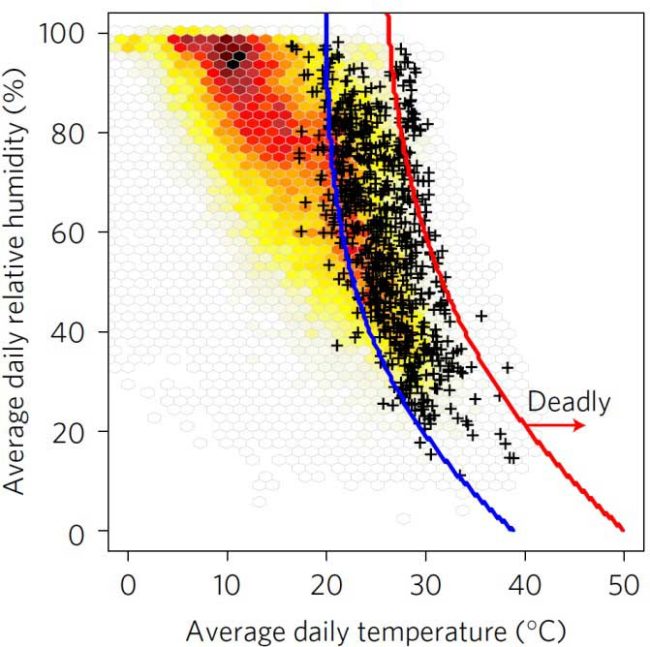 A new study entitled “Global risk of deadly heat” has just become available online. It is very timely given the observation that currently we have a Heat Wave in various locations including the US and the UK at the moment. That however is just a coincidence. The paper has been in the pipeline for some time now.
A new study entitled “Global risk of deadly heat” has just become available online. It is very timely given the observation that currently we have a Heat Wave in various locations including the US and the UK at the moment. That however is just a coincidence. The paper has been in the pipeline for some time now.
What makes a Heatwave potentially deadly?
The term they specifically use within the paper to describe a “deadly” heat wave is “conditions .. exceed human thermoregulatory capacity“. What this means is that once the air temperature reaches and then exceeds the human body temperature (37 C, 98.6 F) then heat starts to accumulate. Actually that’s a tad simplistic on my part because humidity also plays a rather important role. As humidity increases our sweating becomes less effective at removing heat and so that all leads to a potentially deadly combination of the accumulation of heat exceeding our ability to radiate it back out, and that is a serious problem.
The term used to describe the condition where you are absorbing more heat than you dissipate is “hyperthermia“.
The reality of what happens when we reach such a tipping point is rather starkly illustrated by real examples. During the 2003 European heatwave, 70,000 people died. In the 2010 Moscow heatwave, 10,000 people died. These are staggering examples of the risk to life posed by heatwaves when we breach a human tolerance threshold.
The Deadly Heatwave threshold
As part of the study they collected data on 783 cases, from 164 cities in 36 countries, where people have died during heatwaves. Their analysis of the climatic conditions on those cities at those times revealed a common threshold of temperature and humidity beyond which conditions turned deadly (Blue line in Figure below).
To increase the degree of confidence, the researchers calculated a 95% confidence probability around such a threshold (red line in Figure below), which yielded a threshold beyond which only deadly heatwaves have been reported.
The Impact of a Changing Climate
The study also highlights that Climate change will lead to an increase in these deadly heat waves. In summary …
- Today about 30% of the human population is exposed to deadly heat waves for at least 20 days a year
- By 2100 this will have increased to something between 48% and 74%. Where we are between 48% and 74% by 2100 will be very much determined by how well we do at addressing climate change.
Bottom Line: The increasing threat to human life from excess heat is not only inevitable but it will greatly increase if we do not reduce greenhouse gases.
Visualisation of the projections
Along with the paper they also have an on-line tool that shows you their projection results for various climate change scenarios.
It is described as follows:
This web-app counts the number of days in a year when conditions of temperature and humidity surpass that [deadly heat wave] threshold and thus pose a risk of death (i.e., the number of deadly days). The map and time plots are based on the average of 20 Earth System Models developed for the recent Coupled Model Intercomparison Project Phase 5, under scenarios RCP26, RCP45 and RCP85, which represent a range of conditions from strong reductions of CO2 emissions to business as usual, respectively. The application also allows visualizing the temperature and humidity of any place for a given year in comparison to the threshold; that graph is based in the projections of one Earth System Model only.
Human Morality
A rather important point to note is that this is not about human mortality. Instead it is a projection of an increase in our exposure to heat waves that cross a specific threshold and become potentially deadly. What can be anticipated is that as this happens more frequently, we will adapt by utilising air conditioners.
That adaption, rather ironically, will of course lead to more greenhouse gas emissions to generate the power to run those air conditioners, and thus will make the problem even worse … unless of course we utilise renewables for that increased demand.
Tweets
Extremely hot land surface temps on today's MODIS (Terra)… reaching nearly 150°F in the deserts of the Southwest (https://t.co/GJoMrlSQyu) pic.twitter.com/XHCCc5aRSE
— Zack Labe (@ZLabe) June 20, 2017
A third of the world already faces deadly heat waves. It could be nearly three-quarters by 2100 https://t.co/UKR9Lw0EAI
— Chris Mooney (@chriscmooney) June 19, 2017
Deadly heat waves could impact half to 75 percent of the world's population if greenhouse gases aren't curtailed https://t.co/zwDpQydZ9c pic.twitter.com/B1RCecBRTe
— Climate Central (@ClimateCentral) June 19, 2017
Deadly heat waves are going to be a much bigger problem in the coming decades due to climate change, researchers say https://t.co/RzomY9Frhu pic.twitter.com/NCEqNISA8y
— CNN (@CNN) June 19, 2017
Heat waves will get worse and affect more people, study says https://t.co/Fa4wtMvGdR pic.twitter.com/Ol4wsWY55P
— NBC News (@NBCNews) June 20, 2017
Due to climate change, heatwaves around the world become incresingly prominent and deadlyhttps://t.co/EyXZqCmreG pic.twitter.com/ao3FeGSIFd
— AFP news agency (@AFP) June 19, 2017
Study: 74% of Earth's people may be exposed to deadly heat by 2100 if nothing is done to address climate change. https://t.co/iPilmU2Rd4
— Axios (@axios) June 20, 2017
Are heatwaves ‘worsening’ and have ‘hot days’ doubled in Australia in the last 50 years? https://t.co/don7w1xZFK @ConversationEDU #QandA pic.twitter.com/pjH9kZGrIc
— Lucinda Beaman (@Lucinda_Beaman) June 20, 2017
